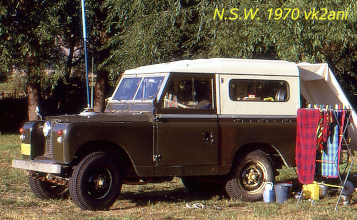Heathkit Amateur Radio Projects
My first transceiver was a HW-101 acquired and built in 1972. It was powered from a HP-13 DC power supply and a huge regulated supply made from an old DEC PDP-8 power supply rescued from scrap. Later I made it "portable" by installing it in a 19" drawer and rugged box (heavy) from a UK teletype converter. Modifications were e.g. a soft voice limiter, an external magic band tube for receive AGC level and an AC fan with converter (this was in the days before DC fans). I still have it, but not used for years.
Much later I bought a partly completed HW-101 and an SB-201 with the aim to make up a traditional Heathkit ham station. It had to wait until 2007 and the 50th anniversary of the Jamboree on the Air to tackle these projects and - surprise! - they got completed in time and were successfully used!

My restored HW-101 and SB-650 system - both MkII - in my "mountain shack" → click on picture to enlarge.
Just in case you wondered: yes, the HW-101 above has inherited the dial mechanism and the LMO fron a wrecked SB-102.
The partly assembled radio was really nice and unused but had no tubes, some minor parts missing and horrible soldering. So everything was taken to bits first, the boards redone (including a few mods documented by other hams), checked and the wiring harness neatly terminated. All electrolytic caps were replaced (many using small tantalum units) and NOS tubes fitted [also refer to Restorer's Note Care of Series-Parallel Filament Circuits]. The finals are 6883s (12.6V, heater rewired) and in the IF section the 6EA8s were replaced by 6LM8s. Then came what made me call this MkII: taking parts from a SB-102 parts radio, the VFO was replaced by the solid state factory built unit, the SSB crystal filter (b/w 5kHz @-60dB rather than 7kHz) changed, the CW filter added, the PA coil (ceramic) and the neutralizing circuit changed. For the VFO and the SB-102 escutcheon the front panel cut-out had to be modified. Finally two very small DC fans were added to the rear panel and the HP-23 brought up to scratch. Did it work? Yes, the radio looks nice and performs well and has been used many times since. Pictures will follow eventually...
An design analysis and detailed "how-to" instructions with references to the Heathkit assembly manual.
- HP-23B power supply with RL PCB by WB8VGE.
This is a very elegant solution using a PCB and modern parts to refurbish all HP-23 variants. One of my HP-23 units was rebuilt in this way. It looks nice and works perfectly! Unfortunately the "Heathkit Shop" is currently suspended. To give an idea of this project, the original assembly notes (local copy, with kind permission of Mike) are here. As soon as I've taken a few pictures of my unit they will be available here.
The SB-650 has been restored and the details of this process are on the SB-650 page.
- SB-610 Station Monitor for SB/HW Radios
Been frustrated with the diagrams available on the Web? Here is a freshly scanned high-resolution circuit diagram. You can finally read all those pin numbers and test voltage indications! Print it e.g. with Adobe Acrobat Reader in "poster mode".
- SB-201 HF Linear Amplifier, refurbished and upgraded
The SB-201 (that is a SB-200 minus 10m) was well built and in good shape but still partially taken apart and rebuilt using more professional materials and including various hints by other hams. No attempt was made to add 160m or 10m or to increase power etc., but the input circuits had to be redesigned. There are quite a few items that need attention and only recently I found a writeup that includes many of the things I did (see link in the sidebar) in a similar way. After the work I had good and solid performance of 600W+ using RCA or CETRON 572B tubes [also refer to Restorer's Note Preparing Transmitter Power Tubes for Use after Storage] and near perfect input SWR driving it with my HW-101 (not at full power). A writeup with pictures might follow eventually...
Still waiting on the shelf are a few other classic Heathkit items:
- HW-12 and HW-32A, 80m and 20m mobile HF transceivers
- HP-13, DC power inverter for HW and SB series transceivers
Questions regarding details for refurbishment will - if possible - be answered. Unfortunately manuals cannot be supplied.
